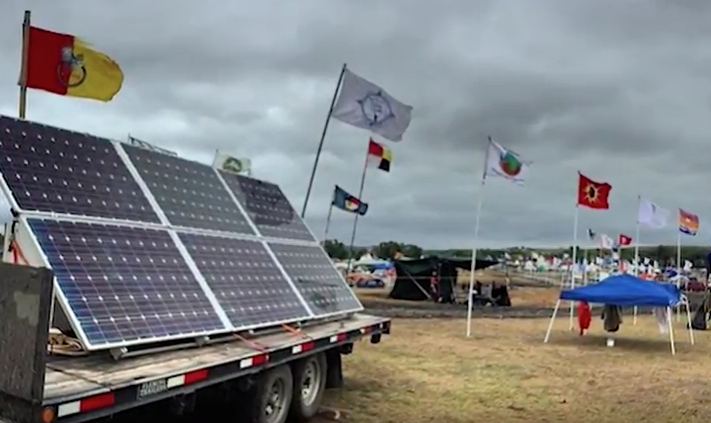
Standing Rock Protesters Are Now Equipped by Native American Solar Entrepreneurs
At the Standing Rock Reservation in Cannon Ball, North Dakota, Henry Red Cloud went down on his knees on the snow-covered ground.
He didn’t seem like he was bothered by the cold as he secured an outlet to a solar air heater with his bare hands, one out of eleven which he installed in December at the Camp in Oceti Sakowin to assist protesters keep warm especially as temperatures fell below zero degrees.
Later, in an interview with ABC News, 57 year old Red Cloud said the protesters were outside all day and they would still experience four months of winter in the Northern Plains.
For months Native Americans, environmental activists and their allies in their thousands camped out near the Standing Rock Reservation protesting against the Dakota Access Pipeline. In July, the Standing Rock Sioux Tribe took legal action to stop the four-state crude oil pipeline project, insisting they were never really consulted before they started construction.
“Water protectors,” as the protesters choose to call themselves, argue that the pipeline which is nearly completed will cause a threat to their water supply and cut across culturally sacred sites. Also, an 1851 treaty that specifically states that the Native American tribe owns the land in question was cited.
The CEO of Energy Transfer Partners – Kelcy Warren- the Texas-based firm that’s constructing the pipeline, stated that there were unsupported facts that the pipeline will affect local water supply and that they conducted “multiple archaeological studies with the state historic preservation offices and no sacred items were found along the route.
Seen as one of the largest demonstrations by Native Americans in decades, the pressure to permanently close the pipeline has caused a lot of friction between the local authorities and “water protectors”.
After the Army Corps of Engineers, reporting to the Department of Defense, announced its refusal to approve an easy way to allow the pipeline in contention to cross beneath Lake Oahe, many of the protesters left the camp.
Though media showed a major win for the protesters, the decision may not have stopped work on the controversial pipeline permanently as the Obama administration nears its last days in the White House.
President-elect Donald Trump has stated his support for the Dakota Access Pipeline which cuts across North and South Dakota, Illinois and Iowa to be completed.
Even though protesters left after the announcement by the Army, hundreds still remain and have put up temporary shelters to keep themselves warm this winter.
On Dec. 21, Red Cloud returned to visit the camp for the 5th time and continued to fix various systems providing light, electricity and heat from renewable energy sources, including wind and solar. Also, Lakota Solar Enterprises, a renewable energy firm owned by a Native American which operates in South Dakota, has taught hundreds of protesters on how to install the systems themselves to enable them live independently while embracing green technology.
“There’s need for us to leverage the sun and start living with the earth and the wind and the sun,” he said. “Our ancestors did it and so can we.”
Red Cloud who is a member of the Tribe of Oglala Lakota on the Pine Ridge Reservation in South Dakota, said he developed an interest in renewable energy because he wanted to help poverty stricken Native American communities like his own that are affected by high unemployment rate and climate change.
According to data from the American Indian Humanitarian Foundation, the population of Pine Ridge Reservation that live below the poverty line is about 97% and almost 90% are without a job. Electricity, clean water, adequate heating and sewage systems are non-existent in thousands of homes.
The energy firm owned by Red Cloud hires members of the tribe to produce and set up solar air heating systems for Native Americans all over the Great Plains. The Renewable Energy Center, which gives practical training and resources to develop skills in renewable energy technology and sustainable building practices to tribes across the United States, is also co-managed by Red Cloud.
Red Cloud told ABC News that his firm was creating an economic opportunity for Native Americans and also helping tribes become energy sufficient. They have the resources, the sun and the wind.
For consistently being at the forefront of policy changes at the local level to diversify energy choices for Americans, creating jobs and adding new clean energy to the grid, Red Cloud was one of the people honored by the President as an “ardent supporter of change.”
“I just found myself eating lunch with President Obama at the White House,” Red Cloud chuckled.
On over 2 million acres owned by the Pine Ridge Reservation, Red Cloud and his partners are also erecting sustainable homes with the use of natural materials, combating deforestation by planting lots of trees and cultivating farms organically with alternative sources of energy.
Red Cloud, who is the father of 17 children and also a direct offspring of Lakota war chief, is introducing these environmental-friendly concepts to the Standing Rock Reservation to support the tribes fighting the pipeline.
“Together we’re going to make history and begin to embrace green energy sources. It is a gradual process,” he told ABC News. “We must move forward together.”




